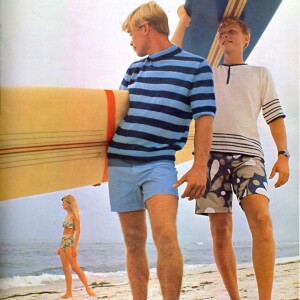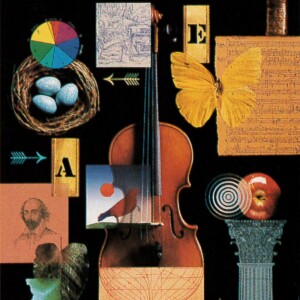Silent Generation
Silent Generation is a Chicago-based cultural analysis podcast that surveys the cultural consequences of car-oriented development in the mid-20th century. It explores what was lost between the Silent Generation and Generation Z, pointing to negative outcomes (nihilism, regional homogeneity, and low-trust societies) and potential antidotes (subcultures, secular social movements, and moral codes). Topics discussed include aesthetics, fashion, history, and urbanism. Find us on Instagram: silent.generation
Episodes
![Ep. 76: Malls [EXTENDED TEASER]](https://pbcdn1.podbean.com/imglogo/ep-logo/pbblog17628020/Malls_2_1400_300x300.jpg)
7 days ago
7 days ago
Full episode available on Patreon: https://www.patreon.com/SilentGeneration
On this week’s episode of Silent Generation, Joseph and Nathan discuss one of the biggest culprits of car-oriented development in the mid-20th century: malls. The boys begin by surveying several malls in Chicago (900 N. Michigan, The Water Tower Place, Block 37, and Ford City Mall) before delving into the largest malls in the country (Mall of America, American Dream Mall, and King of Prussia Mall). They then discuss a multitude of mall brands, noting the mall goth feedback loop generated by Hot Topic and the toxicity of Bath and Body Works. They conclude by discussing the urbanist critique of malls and what should be done with dying ones.
Links:The Economics and Nostalgia of Dead Malls by Nelson D. SchwartzThe Great American Shopping Mall: Past, Present, and Future by Spencer LiThe Perfectly Optimized Building for Late Capitalism - Stewart HicksOpening of Minnesota's Southdale Center99 Percent Invisible: Meet me by the fountainHow Malls Are Evolving In The U.SWhat Is a Class A Mall?Why Restaurants Have Become So Important To Shopping MallsWater Tower Place ‘Past Its Prime’ As A Mall — But Mag Mile Recovery In Full Swing, Backers Say by Melody MercadoThe Only Thing To Do in a Dying Mall by Edward Robert McClellandWhat is The Metropolitan? What to know about the new urban village in Phoenix by Taylor SeelyMeet the ‘Queen Spinner of Shell Shock,’ a local celebrity at MOA by Nicole KiSpencer’s Gifts existed back in the ‘40s as a mail order catalog that sold donkeysYankee Candles Levels of AbstractionMall Chicken Made Me Feel More American by Su Jit-LinLuxurydeptstore Instagram accountThe Great Places Erased by Suburbia - NotjustbikesWhat We Should (Actually) Do with Dying Malls - Chuck from Strong Towns
Artwork:1990s aerial photo of Glendale Galleria and pre-Americana
Recorded on 6/22/2025

Tuesday Jun 17, 2025
Tuesday Jun 17, 2025
On this week’s episode of Silent Generation, Joseph and Nathan detail all of the garments men wear to the beach and the various ways they make men look attractive. They begin with beachwear bottoms (speedos, jammers, box leg trunks, swim trunks, boardshorts), before discussing tops (tank tops, Hawaiian shirts, button downs, Italian knits), and accessories (straw hats, sandals, dive watches). Afterward, the boys examine how the version of preppy style common in coastal Southern states naturally resembles beachwear, citing the Ratliffs from the most recent season of The White Lotus as their primary example. They then discuss beachwear in additional TV shows and movies (The Beach, Seinfeld, and Magnum PI) before concluding with an exposé on shirtlessness.
Links:Beachwear Pinterest board: https://www.pinterest.com/silentgeneration/beachwear/ Bitches from Wisconsin be like BEACH DAY memeBitches from Chicago be like BEACH DAY memeMilverineA cool guide about swimwear color safetyInterview: The Designers of Chubbies Shorts by Geoffrey BrownMen's Swimwear Guide - Bathing Suits for Gentlemen: Trunks, Briefs & Speedos1970’s Men’s Swimwear Tik Tok videoMacy's Beachwear June 2025 - Chicago, ILYou can’t arrest me my dad is a lawyer memeMike White Teases Location For Season 4 Of ‘The White Lotus’ by Peter WhiteThe White Lotus Costume Designer Alex Bovaird on Season 3's Designer-Loving Blondes, the Catalog-Worthy Ratliffs, and Chelsea's DIY Expat Style - Who What Wear PodcastBONUS: Alex Bovaird Returns! The White Lotus Costume Designer on Every Fashion Easter Egg in Season 3 and the Impact of Her Costumes - Who What Wear PodcastDuvin DesignVacation Brand SunscreenOrlebar BrownFrescobol CariocaChubbies
Artwork:Surfers
Recorded on 6/15/2025
![Ep. 74: Gayborhoods [TEASER]](https://pbcdn1.podbean.com/imglogo/ep-logo/pbblog17628020/Gayborhoods_2_1400_300x300.jpg)
Monday Jun 09, 2025
Monday Jun 09, 2025
Full episode available on Patreon: https://www.patreon.com/SilentGeneration
“Gayborhoods” (also known as gay villages) are gay neighborhoods that emerged in the United States at the end of World War II. Returning soldiers were sent home to port cities like New York City and San Francisco, and the sudden influx of gay veterans in those places caused a profusion of gay bars to appear. But how did clusters of LGBT nightlife venues come to gain official recognition as neighborhoods? On this week’s episode of Silent Generation, Joseph and Nathan begin by detailing how Boystown in Chicago came to be the first officially recognized gayborhood in the country. They then survey gayborhoods in several other cities (Milwaukee, New York City, and San Francisco) before debating the pros and cons of living in gayborhoods in the modern era.
Links:
From Antarctica with Love by Allegra Rosenberg
Milestones in the American Gay Rights Movement
The new LGBT neighborhood: Everywhere
Searching for the Last Lesbian Bars in America
Why Do Lesbian Bars Keep Disappearing? by Stef Rubino
What should a gay district look like in Detroit? Survey seeks input by Micah Walker
A Tavern On (Almost) Every Corner: Why Did So Many Chicago Bars Disappear? by Jake Smith
Making Chicago’s Boystown by Steven Jackson and Jason Nargis
Boytown: How Chicago Got its Gay Neighborhood
The History of Boystown's Rainbow Pylons
Decoplex - CARI Aesthetic
Labor Dispute Closes Berlin, the Beloved Chicago Gay Bar by Emily Schmall
Resistance Remains in Renaming of Chicago’s ‘Boystown’ Neighborhood to ‘Northalsted’ by Miguel Johnson
Berlin Nightclub Workers Call For Boycott As They Fight For Contract by Amber Stoutenborough
Berlin nightclub union demands
OUTgoing: Mapping the Hidden History of New York’s Gay Nightlife by Jeff Ferzoco
Photograph of the gay village in Manchester in 1995
The Simpson’s gay pride parade scene
Women & Women First book store
SoDoSoPa
Artwork:
Gilbert Baker & “Raise the Rainbow” Workshop
Recorded on 6/1/2025

Wednesday May 28, 2025
Wednesday May 28, 2025
Normcore is a “a post-authenticity coolness that opts into sameness.” The term was first coined by the trend forecasting group K-HOLE in their 2013 report Youth Mode: A Report on Freedom, which was a larger philosophical deliberation on the degree to which people should remain alternative into adulthood. This week’s episode of Silent Generation focuses on how the fashion world’s misclassification of normcore as an aesthetic caused internet aesthetics to become less subculture-oriented after the mid-2010s. Nathan and Solana begin by discussing the history of internet aesthetics by breaking them down into four categories and three periods: consumer aesthetics, early internet subcultures (2009-2014), Vaporwave-inspired aesthetics (2014-2020), and Tik Tok aesthetics (2020-2025). They then discuss the true meaning of K-HOLE’s report and question what normcore fashion conceptually looked like. They round out the episode by recapping the reasons why normcore killed off the subculture component of internet aesthetics: aesthetics could now be vibes or metaphysical concepts, aesthetics became a formula that could be capitalized off of by brands, and internet aesthetics became more fashion-centric.
Links:Youth Mode: A Report on FreedomNormcore: Fashion for Those Who Realize They’re One in 7 Billion by Fiona DuncanNormcore: Fashion Movement or Massive In-Joke? by Alex WilliamsNormcore Never Died. It Just Got More Expensive by Vanessa FriedmanNormcore Was Always A Misunderstood Fantasy by Delia CaiASOS: What is Normcore/90s Normal? ASOS explains...Gap’s Dress Normal Campaign Isn’t Working Because Normal People Don’t Want to Be Normal by Rachel Raczka
Artwork:Seinfeld
Recorded on 5/25/2025

Tuesday May 20, 2025
Tuesday May 20, 2025
Utopian Scholastic is an aesthetic that was popular in the education field from the late 1980s to early 2000s. It consists of stock image collage, early CGI, references to academia, references to surrealism, and serifed fonts. On this week’s episode, Joseph and Nathan go into a deep dive of Utopian Scholastic and begin by discussing how the aesthetic was first identified by someone inspired by the Consumer Aesthetics Research Institute. They then theorize how factors like the echo boom, utopian beliefs about the internet, and the relative parity of traditional and digital mediums caused Utopian Scholastic to first emerge. Amongst other things they discuss how Frasurbane acts as a base for the aesthetic and how the Eyewitness TV show replicated the style of DK Eyewitness books.
Links:
Pinterest board: https://www.pinterest.com/silentgeneration/utopian-scholastic/
Utopian Scholastic CARI Page
Utopian Scholastic Aesthetics Wiki Page
Evan Collin’s Utopian Scholastic Are.Na Page
The Most Overlooked Aesthetic : Utopian Scholastic by Kat Online
Utopian Scholastic Designs from a Pre-9/11 World
The post in Global Village Coffeehouse and Suze Huldt’s comments
Peggy McNamara’s art website
Ship With Butterfly Sails by Salvador Dali
DK Eyewitness Intro
The Making of Eyewitness
Get Lit: Grown-Up Book Fair
Artwork:
The Arts in Education Poster
Recorded on 5/18/2025
![Ep. 71: IKEA [TEASER]](https://pbcdn1.podbean.com/imglogo/ep-logo/pbblog17628020/IKEA_5_1400_300x300.jpg)
Wednesday May 14, 2025
Wednesday May 14, 2025
Full episode available on Patreon: https://www.patreon.com/SilentGeneration
On this week’s episode of Silent Generation the boys discuss what makes IKEA one of Joseph’s favorite companies. They begin by briefly summarizing how IKEA was founded by Swedish entrepreneur Ingvar Kamprad in 1943 before detailing the various innovations that made it successful (the showroom model, flat packing, and self-assembly). They then talk about how IKEA acts as a point of cross-cultural exchange between Sweden and the United States through its furniture and food products. Amongst other things they discuss how IKEA just released their largest premium collection ever and may be experiencing the effects of premiumization, how IKEA was a pioneer in using recycled materials but is still responsible for 1% of the world’s annual wood consumption, and how IKEA has eight categories of consumers that they cater to but most strongly appeals to people in their 20s.
Links:
Everyday Tastes from High-Brow to Low-Brow, 1949
Everyday Tastes from High-Brow to Low-Brow, Modern Interpretation
Hacking IKEA - 99% Invisible
IKEA - Acquired Podcast
IKEA Museum
House Perfect by Lauren Collins
IKEA Invented "Eureka Spiritis" to Showcase Its Quality Furnishings by Laura McQuarrie
At what age do people stop shopping at Ikea? by Zachary Crockett
What's New at IKEA | IKEA's New LUXURY Collection!
Why You Might Want To Throw Away Your Black Kitchen Utensils and Takeout Containers by Christine Byrne
These Ugly Big Box Stores are Literally Bankrupting Cities - Not Just Bikes
Artwork:
IKEA Store in Yokohama, Japan
Jmho, CC0, via Wikimedia Commons
Recorded on 5/12/2025

Wednesday May 07, 2025
Wednesday May 07, 2025
Scene is a youth subculture that evolved from emo in the mid to late 2000s. Members of the subculture were typically referred to as “scene kids”, but scene kids with large online followings were also referred to as “scene queens” or “scene kings.” On this week’s episode of Silent Generation, Joseph and Nathan begin by sharing their theory that scene spread in a diffuse manner throughout exurbia (particularly in the Sun Belt) due to early social media sites like Myspace. They then detail the elements of scene fashion (brightly colored hair, heavy eyeliner, skinny jeans, band tees, kandi bracelets, and cartoon characters) before examining notable scene queens like Kiki Kannibal, Ambrehhh Is Dead, and Vanna Venom. Amongst other things they discuss how scene kids would act performatively hyper in the way that emo kids would act performatively sad, how Warped Tour’s lineup reflected the wide range of musical genres scene kids liked (metal, EDM, crunkcore), and how modern Zoomers and TikTok influencers have reinterpreted scene through scenecore.
Links:Scene Kids Pinterest board: https://www.pinterest.com/silentgeneration/scene-kids/ “Scene Kids” on Google TrendsFrom Hardcore to Harajuku: The Origins of Scene Subculture by Ethan StewartThe comprehensive guide to scene culture (from a former scene kid) // video essay by SaoirseThe Scene Queens Of Myspace: Web’s First Ever Stars (2000s Guide) by Vitalyspaceeveryday hair&makeup routine by Ambrehhh Is DeadKiki Kannibal: The Girl Who Played With Fire by Sabrina Rubin ErdelyKiki Kannibal’s necklacesScene Wolf - Know Your MemeScene Nostalgia/ fuckyeah2012From a real 2000-2010s former scene girl.. (w/ proof pix and playlist - Reddit postFreaxx - brokeNCYDEAlcohol - Millionaires23 Former Scene Kids From The '00s Who Glowed The Heck Up by Anna KopskyHow zoomers think skinny jeans look vs. how millennials think skinny jeans look
Artwork:Ambrehhh Is Dead
Recorded on 5/5/2025

Wednesday Apr 30, 2025
Wednesday Apr 30, 2025
Vernacular architecture is architecture that uses local materials and traditional techniques to construct buildings without the guidance of licensed architects. It is surprisingly common in the United States despite the country's young age, including in cities like Chicago. This week the boys are joined by Will Quam, the founder of walking tour company Brick of Chicago, to discuss Chicago's rich vernacular traditions and building types. Amongst other things they discuss how the Great Chicago Fire led to the proliferation of brick architecture throughout the city, how Chicago produced over a billion common bricks per year at the peak of brick production, how many of the city's two and three flats were built using "plan books," and how the city has a "bungalow belt" of bungalow homes that were built in the 1920s.
Links:Brick of Chicago website - https://www.brickofchicago.com/ Brick of Chicago - Instagram PageArchitecture Without Architects by Rusofsky BernardVernacular Architecture by Henry GlassieOut of the Loop: Chicago Vernacular Architecture ForumChicago Vernacular ArchitectureThe Chicago Workers Cottage InitiativeAre Two-Flats Only A Chicago Thing? Why These Uniquely Chicago Homes Have Thrived For A Century by Kelly BauerHow bungalow-y is the Bungalow Belt? by Daniel Kay HertzAfter design competition, architect will get to build vision for new Chicago two-flat by Sara FreundEven the Moon Has a Dark Side: A Critical Look at Vernacular Architecture by Sanjoy Mazumdar
Artwork:Provided by Will Quam
4/28/2025
![Ep. 68: Historical Dressing & Reenactment [EXTENDED TEASER]](https://pbcdn1.podbean.com/imglogo/ep-logo/pbblog17628020/Historical_Dressing_2_1400_300x300.jpg)
Thursday Apr 24, 2025
Thursday Apr 24, 2025
Full episode available on Patreon: https://www.patreon.com/SilentGeneration
Historical dressing refers to the act of wearing clothing that is authentic to a specific time period, while historical reenactment refers to the act of recreating past events (such as battles). These two overlapping activities and communities have much in common but are rarely analyzed together. On this week’s episode of Silent Generation, Joseph and Nathan begin by considering the psychological motivations behind historical dressing and reenactment. They then detail the various types of historical reenactment, where to buy reenactment clothing and supplies, and why some people chose to wear historical clothing daily. Amongst other things they discuss how “farb” is used as a pejorative term to describe inauthentic reenactors, how tailors like The Progressive Tailor hand stitch their clothing, how Dandy Wellington popularized the phrase “vintage style, not vintage values,” and what the debate around vintage values in the community really means.
Links:
I was obsessed with the mid 19th century as kid Blunderyears post
Uniforms: Why We Are What We Wear by Paul Fussell
The Grenadier Company
The Grenadier Company’s crashing out Instagram post
The Ragged Victorians – The Great Unwashed
The Milwaukee Vintage Style Society
Deer Hunting in the Oregon Cascades, circa 1925.
The Progressive Tailor - Instagram Page
The Progressive Tailor - Facebook Page
Pinsent Tailoring - https://www.pinsenttailoring.co.uk/
Pinsent Tailoring - Instagram Page
Dandy Wellington - Instagram Page
Mistress Pennywhistle - Instagram Page
What We Each Wear in a Week: 3 Daily Historical Fashion Wearers
‘I don’t see jeans in my future’: the people who wear complete historical dress – every day by Ammar Kali
Victorian Era Couple Live Like It's The 19th Century
Millennial Lives His Life In Victorian Era
This woman lives every day like it’s 1958
This man lives every day like it's 1965
The Meaning of ‘Vintage Style, Not Vintage Values’ in the Modern Age by Lena Bramsen
Fashion-focused Jan. 6 rioter who snapped selfies with Roger Stone and white supremacist arrested thanks to Instagram: Feds by Brandi Buchman
Artwork:
Farb
Recorded on 4/22/2025

Tuesday Apr 15, 2025
Tuesday Apr 15, 2025
World’s fairs, now called World Expos, are large global expositions that exhibit the achievements of nations. They originally focused on industry and technology before shifting to a focus on cultural exchange and nation branding in the mid-20th century. On this week’s episode of Silent Generation, the boys go into a deep dive of several notable world’s fairs including the 1851 Great Exhibition in London, the 1893 World’s Columbian Exposition in Chicago, the 1904 Louisiana Purchase Exposition in St. Louis, The 1933 Century of Progress Exposition in Chicago, and the 1964 World’s Fair in New York City. They conclude the episode by talking about how and why the world’s fair has declined as a cultural institution. Amongst other things they discuss how the Ferris wheel was first invented for Chicago’s 1893 world’s fair, how the 1904 St. Louis world’s fair put over 1,000 Filipino people on display, how the Van Wyck Expressway was extended to provide access to the 1964 NYC world’s fair, and how the newest world’s fair just opened in Osaka, Japan this week.
Links:What Was the Great Exhibition of 1851 by Steven BrindleFalsifying History by Destroying Cities - Stewart Hicks1500 Buildings Built in 3 Years - Louisiana Purchase Exposition 1904 - Auto DidacticLong-delayed DiCaprio/Scorsese serial killer film Devil in the White City back on track by Andrew PulverThe 1964 World’s Fair (1996)OSAKA EXPO 2025! All To Know Before You Go!Ticket presales, pavilion completion slow 1 month before Osaka ExpoExpo 2025 Osaka: 8 Must-See National PavilionsThe Fall of The Fair by Harry Swartout
Artwork:NY World's Fair 1964-1965 by PLCjrAttribution-NonCommercial 2.0 Generic
Recorded on 4/13/2025

Joseph & Nathan
Joseph (left) grew up in Las Vegas and works in construction management. Nathan (right) grew up in Chicago and works as a librarian.
Contact us with any questions or suggestions at:
silentgeneration.chi@gmail.com










